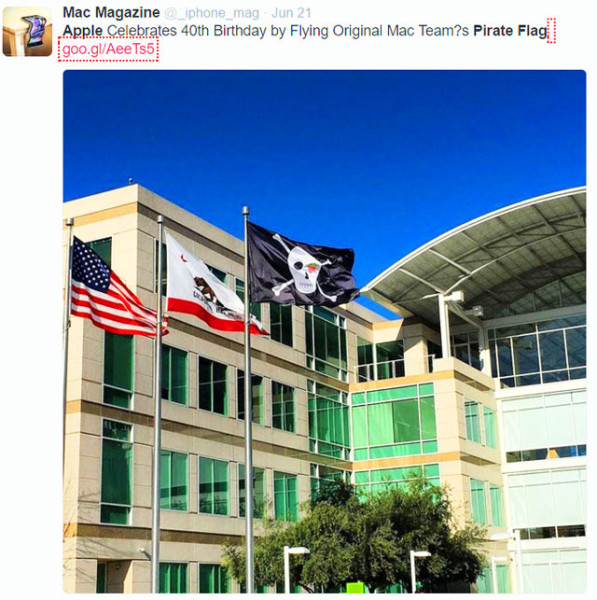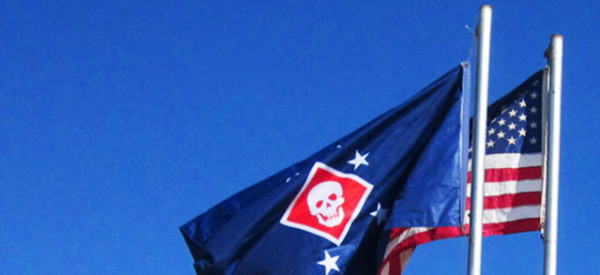Apple hoisted a pirate flag over its Cupertino headquarters to celebrate the company’s 40th anniversary this spring. The flag commemorated the Apple eye-patched Jolly Roger that was first raised above Apple’s skunkworks-style operations in 1983.
The event is not only interesting as a bit of Apple lore, but it raises a pertinent question for branding: Why doesn’t every company design and fly a flag? Company flags are an excellent way to take a stand and declare your spot in the marketplace.
Let’s first look at how Apple came up with a pirate flag to symbolize the spirit of the company. Then we’ll tally up some of the reasons why your company could benefit from doing the same.

How Apple decided to fly a Jolly Roger
The story goes that during an off-site retreat by the Apple team in 1983, Steve Jobs asked the team to consider these three ideas:
- Real artists ship
- Mac in a book by 1986
- It’s better to be a pirate than join the Navy
Growing companies tend to hit spots of dissension and stagnation, and Apple was not an exception to that rule. The company was in danger of letting internal forces stifle its creativity, and Jobs wanted to be the fly that bit the horse’s butt.
Andy Hertzfeld, a member of the early team, wrote “We had started out as a rebellious skunkworks, much like Apple itself, and Steve wanted us to preserve our original spirit even as we were growing more like the Navy every day.”
The Jolly Roger is a perfect fit for the Apple brand. If ever there was a team that deserved to be called “The pirates of silicon valley,” the Apple team would be it. They completely turned the game upside down. Apple forced long-established companies to fight frantically in order to keep their lunch from being eaten by the new pirates on the block. And they failed.
Should every company fly a flag?
Perhaps inspired by Apple’s bold move, The Flag Makers, a company based in Colorado, USA, designed their own pirate flag (see above). And while one might expect a company whose business is making flags would jump on the bandwagon, here are some reasons why your company should consider doing the same:
- Flying a flag indicates permanence. Flags say, “We’re here and we’re not going away.”
- A company flag can help instill confidence and build workplace pride in employees
- A company flag looks good in the eyes of potential investors.
- Flags are like logos; they can solidify a brand and portray the essence of the brand to potential customers and stakeholders.
- Company flags build cohesiveness and give everyone who works for, works with, buys from, or otherwise comes in contact with the company a taste of company culture.
- A flag provides a rallying point. It’s the gathering spot for everyone who loves the company and wants to see it succeed.
- Your flag is an asset, just like your logo and website. Should you decide to sell the company, the flag has value beyond its original cost. A well thought-out flag not only builds brand, it becomes a part of the company.
- Your flag helps you stand out in the crowd. It differentiates your company and your products/services.
- Leaders have flags at the vanguard. Do you want to lead your niche? Design and fly a flag. Be proud of who you are and how you serve others.
- Flags have multiple applications. Yours doesn’t have to wave from the flag post only. Make decals and bumper stickers featuring your flag and your core message. The more you get people informed about your business, the more business you will have.
What’s your opinion on the idea of flags for companies? Does your business have a flag? Do you fly it often? Do you use it across different mediums and channels?
A Simple, but Often Overlooked Way to Build Brand Loyalty – The Bottom Line
Creating and flying a company flag is a relatively inexpensive and time-friendly way to build your brand and take charge of your niche. Flags can help build brand and brand loyalty.
What’s not to love?
A company flag is one of those simple maneuvers that offers plenty of upside potential with very little cost or risk.
Here’s a final thought, though: While nobody really knows why Apple stopped flying their pirate flag (the original was flown for a year or so), it’s possible they were worried about trademark or other legal issues.
If there’s one word of caution here, it’s to get creative, but be as careful with your flag as you are with your logo or trademark symbol.
It’s a tough world for pirates out there.
